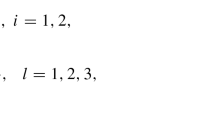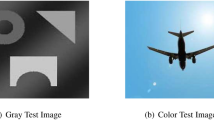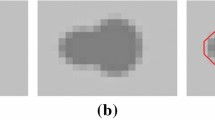Abstract
In this paper, a new level set formulation that can simultaneously segment and correct color images is proposed by combining the illumination and reflectance estimation (IRE) model, the level set method and the split Bregman method. The advantages of our model are mainly summarized in three aspects. First, our model can effectively extract the intensity change information in the images, regarded as the bias field. Based on the accurate segmentation results, our model can correct the inhomogeneous color images by removing the estimated bias field from the original images. Second, the application of the split Bregman method accelerates the iterative process and computational speed, making our model more efficient. Third, the use of the edge detection function in the energy functional makes it easier for our model to detect the target boundary. Perfectly absorbing the above three advantages, our model is applied to segment color medical and natural images with intensity inhomogeneity. Experimental results demonstrate that our model can accurately segment color images and get satisfactory correction images with intensity homogeneity. In addition, numerical comparison results further indicate that the performance of our model for segmentation and correction is significantly superior to the IRE model.














Similar content being viewed by others
References
Bi, L., Kim, J., Kumar, A., Fulham, M., Feng, D.G.: Stacked fully convolutional networks with multi-channel learning: application to medical image segmentation. Visual Comput. 33(6–8), 1061–1071 (2017)
Cai, Q., Liu, H.Y., Zhou, S.P., Sun, J.F., Li, J.: An adaptive-scale active contour model for inhomogeneous image segmentation and bias field estimation. Pattern Recognit. 82, 79–93 (2018)
Caselles, V., Kimmel, R., Sapiro, G.: Geodesic active contours. Int. J. Comput. Vis. 22(1), 61–79 (1997)
Chan, T.E., Sandberg, B.Y., Vese, L.A.: Active contours without edges for vector-valued images. J. Vis. Commun. Image Represent. 11(2), 130–141 (2000)
Chan, T.F., Nikolova, M.: Algorithms for finding global minimizers of image segmentation and denoising models. SIAM J. Appl. Math. 66(5), 1632–1648 (2006)
Chan, T.F., Vese, L.A.: Active contours without edges. IEEE Trans. Image Process. 10(2), 266–277 (2001)
Feng, C.L., Zhao, D.Z., Huang, M.: Image segmentation and bias correction using local inhomogeneous intensity clustering (LINC): a region-based level set method. Neurocomputing 219, 107–129 (2017)
Goldstein, T., Bresson, X., Osher, S.: Geometric applications of the split Bregman method: segmentation and surface reconstruction. J. Sci. Comput. 45(1–3), 272–293 (2010)
Goldstein, T., Osher, S.: The split Bregman method for L1-regularized problems. SIAM J. Imaging Sci. 2(2), 323–343 (2009)
Hettiarachchi, R., Peters, J.F.: Voronoi region-based adaptive unsupervised color image segmentation. Pattern Recognit. 65, 119–135 (2017)
Kass, M., Witkin, A., Terzopoulos, D.: Snakes: active contour models. Int. J. Comput. Vis. 1(4), 321–331 (1988)
Le, Y., Xu, X.Z., Zha, L., Zhao, W.C., Zhu, Y.Y.: Tumour localisation in ultrasound-guided high-intensity focused ultrasound ablation using improved gradient and direction vector flow. IET Image Process. 9(10), 857–865 (2015)
Li, C., Gore, J.C., Davatzikos, C.: Multiplicative intrinsic component optimization (MICO) for MRI bias field estimation and tissue segmentation. Magn. Reson. Imaging 32(7), 913–923 (2014)
Li, C., Kao, C.Y., Gore, J.C., Ding, Z.: Minimization of region-scalable fitting energy for image segmentation. IEEE Trans. Image Process. 17(10), 1940–1949 (2008)
Li, C., Li, F., Kao, C.Y., Xu, C.: Image segmentation with simultaneous illumination and reflectance estimation: an energy minimization approach. In: 2009 IEEE 12th International Conference on Computer Vision (ICCV), Kyoto, Japan, pp. 702–708 (2009)
Li, C., Xu, C., Gui, C., Fox, M.D.: Distance regularized level set evolution and its application to image segmentation. IEEE Trans. Image Process. 19(12), 3243–3254 (2010)
Li, C.M., Huang, R., Ding, Z.H., Gatenby, J.C., Metaxas, D.N., Gore, J.C.: A level set method for image segmentation in the presence of intensity inhomogeneities with application to MRI. IEEE Trans. Image Process. 20(7), 2007–2016 (2011)
Li, Y., Shen, L.: Skin lesion analysis towards melanoma detection using deep learning network. Sensors 18(2), 322–329 (2018)
Min, H., Jia, W., Zhao, Y., Zuo, W.M., Ling, H.B., Luo, Y.T.: LATE: a level-set method based on local approximation of Taylor expansion for segmenting intensity inhomogeneous images. IEEE Trans. Image Process. 27(10), 5016–5031 (2018)
Mumford, D., Shah, J.: Optimal approximations by piecewise smooth functions and associated variational problems. Commun. Pure Appl. Math. 42(5), 577–685 (1989)
Paulano, F., Jimenez, J.J., Pulido, R.: 3d Segmentation and labeling of fractured bone from ct images. Visual Comput. 30(6–8), 939–948 (2014)
Shattuck, D.W., Sandor-Leahy, S.R., Schaper, K.A., Rottenberg, D.A., Leahy, R.M.: Magnetic resonance image tissue classification using a partial volume model. Neuroimage 13(5), 856–876 (2001)
Song, L.: Image segmentation based on supervised discriminative learning. Int. J. Pattern Recognit. Artif. Intell. 32(10), 1854027 (2018)
Wang, L., Li, C., Sun, Q., Xia, D., Kao, C.Y.: Active contours driven by local and global intensity fitting energy with application to brain MR image segmentation. J. Comput. Med. Imaging Graph. 33(7), 520–531 (2009)
Wang, Y.L., Yang, J.F., Yin, W.T., Zhang, Y.: A new alternating minimization algorithm for total variation image reconstruction. SIAM J. Imaging Sci. 1(3), 248–272 (2008)
Xian, M., Zhang, Y.T., Cheng, H.D., Xu, F., Zhang, B.Y., Ding, J.R.: Automatic breast ultrasound image segmentation: a survey. Pattern Recognit. 79, 340–355 (2018)
Xiao, C.X., Gan, J.J., Hu, X.Y.: Fast level set image and video segmentation using new evolution indicator operators. Visual Comput. 29(1), 27–39 (2013)
Xing, F.Y., Xie, Y.P., Yang, L.: An automatic learning-based framework for robust nucleus segmentation. IEEE Trans. Med. Imaging 35(2), 550–566 (2016)
Xu, C., Prince, J.L.: Snakes, shapes, and gradient vector flow. IEEE Trans. Image Process. 7(3), 359–369 (1998)
Xu, G., Li, X., Lei, B., Lv, K.: Unsupervised color image segmentation with color-alone feature using region growing pulse coupled neural network. Neurocomputing 306, 1–16 (2018)
Yang, Y., Boying, W.: Split Bregman method for minimization of improved active contour model combining local and global information dynamically. J. Math. Anal. Appl. 389(1), 351–366 (2012)
Yang, Y., Li, C., Kao, C.Y., Osher, S.: Split Bregman method for minimization of region-scalable fitting energy for image segmentation. In: International Symposium on Visual Computing (ISVC). Lecture Notes in Computer Science, vol 6454, pp. 117–128. Springer, Berlin (2010)
Yang, Y., Wu, B.: A new and fast multiphase image segmentation model for color images. Math. Probl. Eng. 2012, 494761 (2012)
Yang, Y., Zhao, Y., Wu, B., Wang, H.: A fast multiphase image segmentation model for gray images. Comput. Math. Appl. 67(8), 1559–1581 (2014)
Zha, Z.Y., Liu, X., Zhang, X.G., Chen, Y., Tang, L., Bai, Y., Wang, Q., Shang, Z.H.: Compressed sensing image reconstruction via adaptive sparse nonlocal regularization. Visual Comput. 34(1), 117–137 (2018)
Zhang, H.Z., Xie, X.H.: Divergence of gradient convolution: deformable segmentation with arbitrary initializations. IEEE Trans. Image Process. 24(11), 3902–3914 (2015)
Zhang, T.: Optimized fuzzy clustering algorithms for brain MRI image segmentation based on local Gaussian probability and anisotropic weight models. Int. J. Pattern Recognit. Artif. Intell. 32(9), 1857005 (2018)
Zhong, F., Qin, X.Y., Peng, Q.S.: Robust image segmentation against complex color distribution. Visual Comput. 27(6–8), 707–716 (2011)
Zhou, Y.F., Pan, X., Wang, W.P., Yin, Y.L., Zhang, C.M.: Superpixels by bilateral geodesic distance. IEEE Trans. Circuits Syst. Video 27(11), 2281–2293 (2017)
Funding
This study was funded by Shenzhen Fundamental Research Plan (No. JCYJ20160505175141489).
Author information
Authors and Affiliations
Corresponding author
Ethics declarations
Conflict of interest
We declare that we have no conflict of interest.
Additional information
Publisher's Note
Springer Nature remains neutral with regard to jurisdictional claims in published maps and institutional affiliations.
Rights and permissions
About this article
Cite this article
Yang, Y., Jia, W. & Wu, B. Simultaneous segmentation and correction model for color medical and natural images with intensity inhomogeneity. Vis Comput 36, 717–731 (2020). https://doi.org/10.1007/s00371-019-01651-4
Published:
Issue Date:
DOI: https://doi.org/10.1007/s00371-019-01651-4




